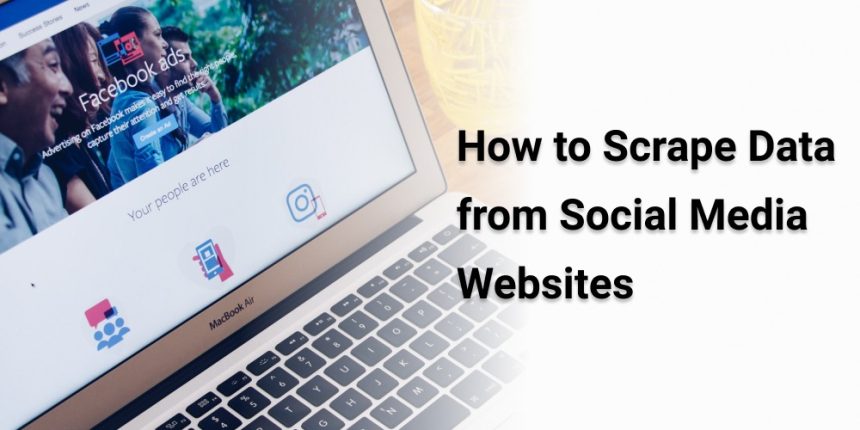Reviews of new products, comments on trending topics, influencer reach, price of products, forums for niche topics- have you ever given a thought about the varying topics and the data that social media platforms have?
Every second, billions of people log in to various social media platforms like Facebook, Instagram, Twitter, TikTok, LinkedIn and YouTube to view and add content. Imagine the vast and diverse user-generated content on such social media platforms!
Now, if your business was to benefit from this data, wouldn’t you want it? How do you collect data that is relevant to your business from social media websites? Here is where social media data scraping comes into the picture.
What is social media data scraping?
Social media scraping or social media mining is an advanced technique to scrape (collect, fetch or mine) relevant user-generated data from social media platforms like LinkedIn, Twitter, Instagram or TikTok. The data mining tools that collect information from online platforms are called web scrapers.
How to scrape data from social media websites?
An advanced scraper collects information from social media websites in this way-
- A social media website scraper sends a series of HTTP GET requests to the website.
- It extracts information underlying the unique HTML site structure
- It copies and saves the information sent by the webserver.
- The data is saved in any preferred format like XML, CSV or JSON files.
Sophisticated social media website scrapers use JavaScript to download gated content on the websites.
The browser automation scraping software and the APIs take the mode of traditional web browsers and interact with web servers to access the content.
Usually, the content is structured on social media websites. For a structured document, we can scrape any of the elements using JavaScript and knowledge of DOM (Document Object Model).
Dynamic content scraping on social media websites involves the use of advanced software and APIs (Application Programming Interfaces) to extract data.
Data can be scraped on the basis of keywords, geographic location, categories, languages or a combination of these.
What are the steps in social media data scraping?
The data collection from the social media websites takes place in three steps-
- Extracting
Data extraction is collecting data from a variety of sources, usually in structured or unstructured form. But the data that is obtained by extraction is in the raw form. This data is unsorted. Some of it might be duplicates, some may be missing. Simply put, this data needs cleansing.
- Formatting
The extracted data is not in a structured format fit for reading. Data parsing is a technique to convert the extracted data into a readable format. The raw data is formatted. For instance, duplicate values will be removed, missing values will be adjusted. A data parser works on the information in the HTML string and formats it. The data parsers can be customized for conversions to the desired format.
- Storing
Once the data is formatted, it is delivered to a single unified format in the server for future use and analysis. The storing part is converting the formatted data into CSV, JSON, TXT file or a table format.
Advanced social media scraping services extract data, refine it and store it in the desired format.
What information is scraped from social media websites?
Data can be obtained from diverse social media platforms like Instagram, Twitter, Facebook, YouTube and LinkedIn. The information scraped from social media websites can be-
- Blog Content
- Reviews
- Groups & Forums
- User IDs
- Emails & Contact Addresses
- Comments
- Product Prices
- Trending Topics
The important step in social media data scraping is identifying the kind of data you need. The next step is to know where to get the data. The last step is deciding how you want to store the data.
What are the benefits of social media scraping?
Big companies are always on the outlook for data on social media. It offers them umpteen benefits.
- Sentiment analysis
Sentiment analysis is a form of market research on social media to gauge customer sentiments by scraping relevant social media website data from comments, shares and reviews. It works when businesses want to launch new products or measure the market impact of any product or change.
- Competitor analysis
Social media scraping services can be effectively used to spy on competitor profiles and get to know everything about the marketing strategies of the competitors. This helps businesses to improvise their strategies and strengthen their position in the market.
- Improved customer service
Brands can improve customer service by identifying opportunities through social media scraping. From comments to reviews, from shares to likes, businesses have to identify the positive trends to attract a better audience. Social media scraping services can also be used to collect data from influencer profiles to know which influencers are better suited to promote the brand.
- Brand monitoring
Social media scraping helps companies mitigate risks associated with negative customer engagement by recognizing them early and working on counteracting the effects. Businesses can also identify products that are bringing in more engagement and boost their online image.
- Trend watching
Social media scraping involves collecting dynamic data from platforms like Twitter, Instagram and LinkedIn to identify and latch on to the latest trends that keep changing by the minute. Companies that jump the trend bandwagon to promote their brands and get new launches usually benefit from increased user interaction.
In a Nutshell
Social media scraping for data that is beneficial to your business is a sure way to increase revenue growth. If you stand to gain by collecting, organizing and analyzing user-generated content on various platforms through social media scraping services, why not go for it?















